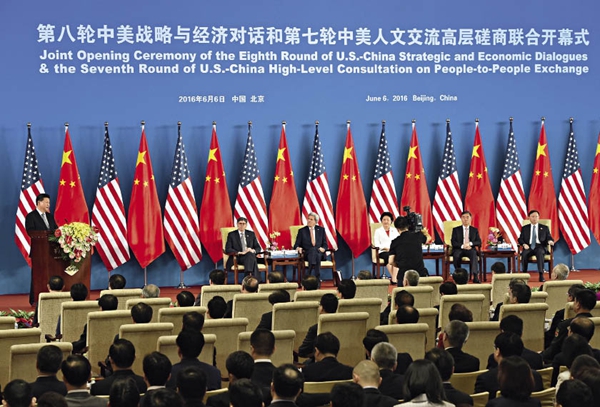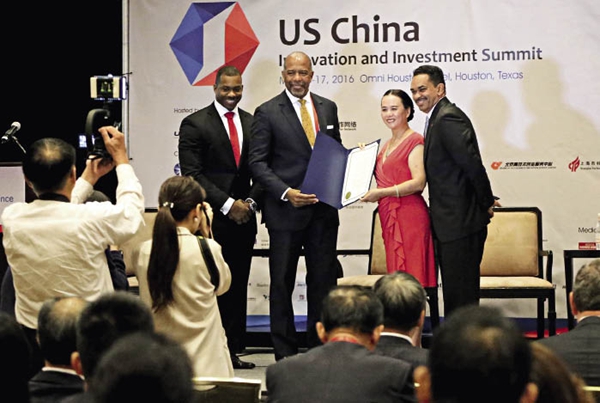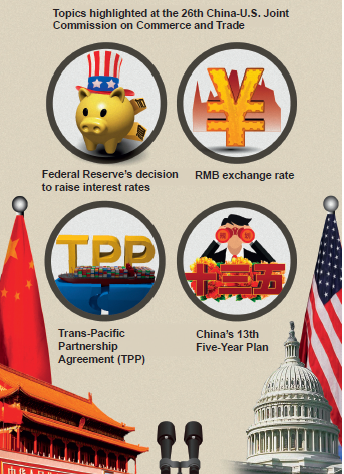By SUN LIPENG
By SUN LIPENG
Rapid Development in Economic and Trade Cooperation
Trade protectionism has tended to resurge around the world since the financial crisis. Though the growth of world trade has slowed, China and the U.S. have witnessed rapid growth in bilateral trade, becoming a highlight boosting world economy.

Chinese President Xi Jinping delivers a speech at the joint opening ceremony of the Eighth Round of U.S.-China Strategic and Economic Dialogues and the Seventh Round U.S.-China High-Level Consultation on People-to-People Exchange in Beijing on June 6, 2016.
First of all, trade interdependence between the two sides continues to deepen. Up to 2015, China was the U.S.’s second largest trading partner, the third biggest export market, and the largest source market of U.S. imports; while the U.S. was China’s second largest trading partner, its biggest export market, and fifth largest source of imports. Second, their bilateral trade scale has risen rapidly. According to the Bureau of Economic Analysis (BEA) of the U.S. Department of Commerce, Sino-U.S. trade volume rose from US $395.13 billion in 2009 to US $662.506 billion in 2015. With an annual average growth of 7.7 percent, the figure surpassed the world average in the same period. Third, U.S. exports to China have risen remarkably. The rapidly expanding consumer market in China, thanks to the country’s steady economic progress and an upsurge in residents’ income levels, directly benefits U.S. exports. BEA statistics reveal that U.S. exports to China soared from US $87.697 billion in 2009 to US $162.248 billion in 2015, with an annual average growth of around 9.2 percent. In the same period, however, U.S. exports to the rest of the world only increased from US $3.54988 trillion to US $4.986992 trillion, with an annual average growth of 4.98 percent. Obviously, U.S. exports to China have grown much faster than to the rest of the world.
On top of that, China’s foreign direct investment (FDI) to the U.S. has been expanding in recent years, owing to the enhancement of its economic strength. Instead of being dominated by U.S. investment to China as before, bilateral investment relationships are now moving towards a more balanced status. China’s investment in the U.S. has been giving a new boost to bilateral trading ties. From 2009 to 2015, China’s FDI to the U.S. increased 21-fold, from US $697 million to US $15.3 billion. By the end of 2015, the number of Chinese corporations and their subsidiaries in the U.S. surpassed 1,900, covering 362 out of 435 congressional districts. In addition to quantity, the quality of China’s investment in the U.S. has also been improving. Investors from China no longer merely focus on the financial industry. Rather, they have ventured into various fields including energy, real estate, services, and high-tech industries. In 2015, China’s investors allocated US $1.8 billion to greenfield investments in the U.S., an increase of 34 percent compared to 2014.
Notably, China’s FDI in the U.S. not only financially benefits Chinese enterprises, but also has positive impact on the U.S. economy. On the one hand, it facilitates local employment; in 2015 alone, 13,000 full-time positions were generated through China’s FDI – a year-on-year growth of 12 percent. Up to now, China’s FDI has generated over 90,000 full-time positions in the U.S. On the other hand, it propels U.S. exports. According to the Rhodium Group, rising FDI from China closely connects markets on both sides. Chinese enterprises in the U.S. are expected to promote more products that are made in the U.S. to export to China, so giving impetus to U.S. export growth.

The first U.S. China Innovation and Investment Summit, the largest of its kind in southern U.S., kicks off in Houston on May 17, 2016.
Moreover, progress keeps being made in terms of China-U.S. Bilateral Investment Treaty (BIT) negotiations. A total of 24 rounds of negotiations so far have achieved substantial developments, though it has been tough going. In July 2013, the fifth round of the China-U.S. Strategic and Economic Dialogue (S&ED) adopted a pre-establishment national treatment clause and a negative-list approach as the groundwork for negotiations. Last year, the two economies started negotiations on the negative list, the second phase of the BIT talks. Despite disagreements over the negative list, the two sides are fully aware of the significance of reaching agreement on the BIT for bilateral trading ties. During his visit to the U.S. last September, Chinese President Xi Jinping, along with his U.S. counterpart Barack Obama, stressed that reaching a high-level investment agreement is a top priority in bilateral economic relations, setting the tone for the prospects of the BIT.
Greater International Influence
In the post-crisis era, collaboration between China and the U.S. in economy and trade not only benefits the two countries, but also generates greater global influence, and contributes to improving global economic governance. For instance, the two nations have been constantly enhancing China-U.S. cooperation through such mechanisms as the Group of 20 (G20) and Asia-Pacific Economic Cooperation (APEC). Against the backdrop of the financial crisis, the G20 has taken the stage to coordinate global economic strategies. China and the U.S. have reached consensus on reinforcing macroeconomic policy coordination and propelling the G20’s transformation from a crisis-response into a long-term governance mechanism. With the theme of “building an innovative, invigorated, interconnected and inclusive world economy,” the aim of this year’s G20 Summit, to be held in Hangzhou in China, is to inject impetus into world economic growth through innovation-driven development and structural reforms. The U.S. has expressed its support for China’s efforts and stance. At the same time, President Obama has voiced support for China’s hosting of the G20 Summit, thus sending a positive message as regards stimulating sustainable global economic growth to the international community. It is believed that the 2016 G20 Summit will bring new opportunities for Sino-U.S. relations.
What’s more, the two countries are jointly making contributions to the reform of international institutions. Today, the progress of major international institutions, including the International Monetary Fund (IMF), the World Bank, and the World Trade Organization (WTO), lags far behind the development of the world’s economic trends, in which emerging developing powers are seeking to forge a bigger global voice. China is willing to take, and is indeed taking on, more international responsibilities, which is in line with the interests of other countries including the U.S. The two economies have been developing good communications in this regard. In December 2015, the U.S. Congress passed its omnibus appropriations for the 2016 fiscal year that covered authorization and funding to implement the IMF quota changes and governance reforms agreed to by IMF members in 2010. This constituted the green light to implementing IMF reforms that have been shelved for nearly five years. According to the IMF reform plan that officially came into effect on January 27, 2016, China has become the third largest member country in the Fund, rather than the sixth as in the past, ranking next only to the U.S. and Japan, with its quota share rising from 3.99 percent to 6.46 percent. This is an important step toward equity and rationality for the reform of international institutions. Moreover, China and the U.S. have closely and sincerely communicated on the issue of the inclusion of the RMB into the IMF’s Special Drawing Rights (SDR) basket. The U.S. has shown support for the RMB’s SDR inclusion on the condition that the currency conforms to existing IMF criteria, which has created a favorable foundation for the RMB to become one of the world’s reserve currencies.
In addition, the two economies have joined hands in driving development of global trade. Both parties have played constructive roles at the Ninth WTO Ministerial Conference held at the end of 2013, in adopting the Bali Package, which included a breakthrough after the stalled Doha Round. During President Obama’s visit to China in November 2014, the two sides reached consensus on resuming negotiations on updating the WTO Information Technology Agreement (ITA), which has created favorable conditions to form the first agreement on tariff cuts since the establishment of the WTO. The Director-General of the WTO Roberto Azevêdo said that ITA expansion is a milestone, as the annual trade volume of 201 information products involved is expected to reach US $1.3 trillion – a figure way larger than the world’s gross trade volume of iron and steel, textiles, and clothing combined.
Broader Channels and Wider Realms
Economic exchanges and collaborations between the two countries have been spurred to advance at different levels. In the last few years, bilateral economic and trade cooperation has been expanding. More pragmatic and targeted, cooperative projects are being increasingly carried out at local and company levels. Local governments on both sides communicate more frequently. By the end of 2015, there were over 44 pairs of friendly state/province relationships and 201 pairs of friendly city relationships between the two countries. Moreover, administrative bodies at various levels have conducted more than 100 exchanges or visits each year. Since 2011, the China-U.S. Governors’ Forum has been held three times, producing a great number of cooperation results in such fields as trade, investment, the environment, energy, and culture. Exchanges of these types have deepened mutual understanding, and enriched the content and implication of new-type relationship between the two countries.
On top of that, Chinese enterprises have been proactively taking part in the SelectUSA Investment Summit. Aimed at reviving U.S. manufacturing and employment hit by the financial crisis, U.S. governments – both federal and local – have striven to attract foreign investment to the country. The SelectUSA Investment Summit initiated at the end of October 2013 served as a platform for global investors. Drawing participants from over 60 countries and regions, the first summit attained great success. Chinese enterprises, meanwhile, have expressed keen interest. Later, in March 2015, 119 representatives from Chinese companies, including renowned groupings like Alibaba, Wanda, Sany, Midea, and Lifan, attended the second summit. The event has facilitated the elevation of bilateral economic collaboration to higher levels.
Cooperation in sectors of the non-traditional economy is also close and steady. For example, China and the U.S. have taken the lead in tackling climate change. Through the China-U.S. Announcement on Climate Change issued in November 2014, both sides have reaffirmed the importance of strengthening bilateral cooperation on climate change while vowing to continue enhancing their policy dialogue and cooperation on advanced coal technologies, nuclear energy, shale gas, and renewable energy. They were also determined to jointly push international climate change negotiations for the adoption of a protocol at the United Nations Climate Conference in Paris in 2015. In December 2015, one of the milestones of this century was achieved at the Climate Conference in Paris, when a legally binding agreement for addressing climate change was agreed to by delegates from 195 countries. According to Vice President of the Brookings Institution Bruce Jones, and Steven A. Tananbaum, senior fellow with the Council on Foreign Relations, the breakthrough in the climate issue has become a successful case for China and the U.S. to lead global cooperation. Following the consensus formed between their top leaders, China and the U.S. joined hands to take measures and share responsibilities and costs, to eventually make their contributions to promoting global climate cooperation. Furthermore, collaboration in hotspot issues including technology, culture and anti-terrorism are being carried out in innovative ways. Bilateral cooperation has shown potential to produce multi-win outcomes for the world economy.
Promising Prospects
To be honest, conflict and competition are unavoidable when we observe bilateral economic ties. Recurrence of economic and trade disputes, the imbalanced economy on both sides, the RMB exchange rates, stricter examination of China’s investments in the U.S. by the U.S. government, China’s market economy status, the issues of the Trans-Pacific Partnership Agreement (TPP), and the Asian Infrastructure Investment Bank (AIIB), among others, require rational and pragmatic communication and solutions. In spite of such issues, win-win cooperation remains crucial to bilateral economic and trade relations to boost promising prospects.

First, China’s resolve in reform and opening-up has been the key stabilizer for the bilateral economic and trade relationship. China’s 13th Five-Year Plan highlights deepening reform in a comprehensive way, further promoting the development of an open economy, and exerting the market’s decisive role. Faced with a slowdown in the world’s economy and sluggish recovery, the IMF has cut its forecast for world economic growth by 0.2 percent and 0.1 percent to 3.2 percent in 2016 and 3.5 percent in 2017, respectively. However, China’s economic growth is expected to rise 0.2 percent to 6.5 percent in 2016 and to 6.2 percent in 2017, because incomes in the country are rising and the labor market is good. China’s structural reform especially will spur domestic demand and stimulate China’s economy to progress in a more balanced way. It is foreseeable that structural reform and an open market in China will increase mutual complementation and generate valuable opportunities for Sino-U.S. economic and trade relations.
Second, economic coordination mechanisms serve as a regulator for the development of bilateral economic and trade ties. Mechanisms including the China-U.S. Joint Commission on Commerce and Trade (JCCT) as well as the S&ED have been playing an important role in boosting cooperation, controlling disparities, and reducing conflict. The two sides should now together probe ways to deepen cooperation in respect of the overall situation, strategy and foresight under the S&ED framework, so as to effectively transmit the current mechanisms to the next U.S. government. Meanwhile, they need to figure out ways to continue the JCCT’s effects, avoid economic and trade conflicts, and foster the stable development of bilateral ties, particularly during the U.S. presidential election cycle. The two mechanisms, which have already become major platforms for the two sides to exchange views and coordinate policies, will certainly exert a more active role in the future.
Last but not least, international cooperation will provide a “new space” for China-U.S. economic and trade ties. The two powers share common interests from a global perspective. Increasingly expanding the size of the “pie” is an effective approach to deal with conflict and competition between China and the U.S. in the economic sector. This is to say, win-win and multi-win outcomes may be realized by expanding international cooperation and advancing exchanges and communication. Collaboration between China and the U.S. in coping with global problems, including climate change, crises, humanitarian assistance, anti-terrorism, and disease control, have developed with highlights and positive factors in bilateral relationships, and will continue advancing ties.
All in all, steadily developing China-U.S. economic and trade relations, encouraged by cooperation, will benefit the two sides as well as the whole world.